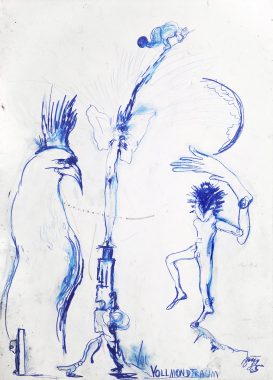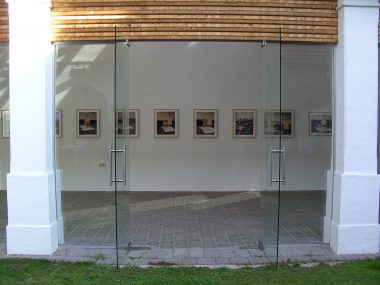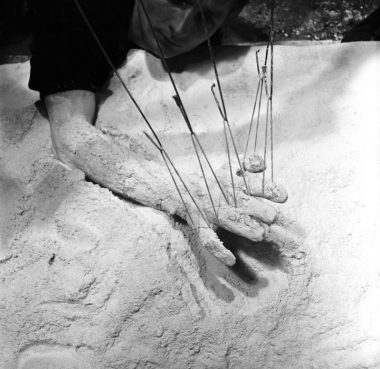1985, oil pastel, coloured pencil on paper, 88 x 62.5 cm
1938 * in Ardning / Stmk.
10.2.2024+ in Graz
1954-1958 School of Applied Arts Graz
1958-1960 Academy of Applied Arts Vienna - left without graduating
1958-1964 Informal drawings and paintings, acquaintance with Alfons Schilling, Otto Mühl, Adolf Frohner, Hermann Nitsch, Rudolf Schwarzkogler, Kurt Kren. 1961 Brus meets his future wife Anna.
1964 First action 'Ana', Vienna, first use of the body as an artistic medium; transition from Informel to 'self-painting'.
1965 Further actions, among others "Self-Mutilation", Vienna, and "Viennese Stroll
1966 Participation in the "Destruction in Art Symposium", London, at the invitation of Gustav Metzger; radicalisation of action art, first production of action scores
1967 "Action with Diana", Vienna
1968 Action "Der helle Wahnsinn", Aachen; Action "Art and Revolution" with Otto Mühl, Oswald Wiener, Peter Weibel, Franz Kaltenbäck at Vienna University, sentenced to 6 months in prison
1969 Escape to Berlin
1970 Last action: "Zerreissprobe", Munich
1970-1975 Return to drawing, publication of the "Organ of the Austrian Government in Exile", the "Schastrommel" or later "Drossel" (until 1977; together with Otmar Bauer, Oswald Wiener, Hermann Nitsch, Gerhard Rühm); interplay of text and image, creation of, among others, "Irrwisch". Interplay of text and image, creation of "Irrwisch", "Der Balkon Europas", "Die Zernunft", "Das Namenlos", among others; joint musical performance "Selten gehörte Musik" with Oswald Wiener, Gerhard Rühm, Dieter Roth, Hermann Nitsch at the Lenbachhaus in Munich
1976 Commutation of prison sentence into a fine after audience of Anna Brus with Federal President Kirchschläger
Since 1976 publication of lyrical works in the publishing house "Das Hohe Gebrechen" by Arnulf Meifert; creation of numerous picture-text cycles, which from then on are described by Günter Brus as "picture-poems" as a genre of their own, among others "William Blake - Poetische Skizzen", "Franz Schreker - Die Gezeichneten"; touring exhibition "Günter Brus - Bild-Dichtungen" in Hamburger Kunsthalle, Kunstmuseum Luzern and Kulturhaus der Stadt Graz as part of "steirischer herbst"; novel "Die Geheimnräger" appears; design of stage sets and costumes, e.g. for "Erinnerungen an die Menschheit" by Gerhard Roth (steirischer herbst 1985)
2008 Laying of the foundation stone of the "BRUSEUM", a museum for Günter Brus at the Landesmuseum Joanneum
2009 Purchase of the literary estate by the Province of Styria
Impressed by German Expressionism at the turn of the century, by Edvard Munch and Vincent van Gogh, then also by Abstract Expressionism and by artists such as Emilio Vedova, he began in the autumn of 1960 with a radically gestural painting that exploded the picture format. Brusen's works from this period are attempts to break out of the classical panel painting. His later companion Otto Muehl, who met him at that time, remembers: "The paint sometimes exploded like a bomb when it hit the picture. That was total creative excess. [...] The whole room was covered with splashes of paint, there was inches of dried paint sludge on the floor." Shortly before his first major exhibition together with Schilling, he had to go into the army in May 1961. After completing his military service, he fell into a psychological crisis and did not start working again until the end of 1962. Brusen's striving to break out of the medium of the 'picture' became clearer. In the following, he created 'spatial pictures' in which the formal boundaries of the canvas no longer played a role.
In 1964 Brus carried out his first performance, working title Ana. From the beginning, it was essential for him to place his own body at the centre of the action, and in the three-part second action, Hand Painting. Head painting. Head painting, a self-painting process that lasted several hours, he was also satisfied with the process. He turned away from painting and carried out numerous actions (self-painting II, self-mutilation, rigor mortis, transfusion, ordeal). All these "actions" can be seen as a further development of informal painting, and painting and handling colours continue to play a central role.
In 1966 Brus and Muehl conceived the idea of Totalaktion as a combination of Muehl's Materialaktion and Brus's self-mutilations. A first sample was given at the Destruction in Art Symposium in London.
In 1967, in the work Osmosis, Pullover, Inhale - Exhale, he dealt with the theme of birth in body language and integrated his little daughter Diana into his 23rd action. Brus' works went further in the direction of total body analysis: he urinated and defecated during the actions, scratched his skin with razor blades and masturbated. In the action Der Staatsbürger Brus betrachtet seinen Körper (1968) at the latest, it became clear that the actions were also intended as a critique of the state. In the same year, an event that went down in art history caused a scandal and was dubbed "Uni-Ferkelei" by the media, as a result of which he was prosecuted and sentenced and finally went into exile.[4] His last action (June 1970), with which he once again tried to go to all physical limits, was sensibly called Zerreißprobe.
Günter Brus participated in Documenta 5 in Kassel in 1972 in the section Individual Mythologies and was represented as an artist at Documenta 6 (1977) and Documenta 7 in 1982.
Brus had already accompanied his entire actionist work with drawings and paintings. From 1970 onwards, he began to write the novel Irrwisch, which was underpinned by numerous drawings, and from this he developed new possibilities for combining literature and visual art. This resulted in works that he calls picture-poems and which opened up a new phase in Brusen's oeuvre, the fruit of which is the rich graphic and literary oeuvre of the 1970s and 1980s. For his life's work he was awarded the Great Austrian State Prize for Fine Arts in 1996.
Since summer 2005, Brus has been a columnist and illustrator for the Austrian monthly magazine Datum. He lives and works in Graz and on the Canary Islands.
With a collection purchase for the Neue Galerie Graz, Kurt Flecker, the then cultural advisor of Styria, laid the foundation stone for his own Brus Museum in 2008. The "BRUSEUM", which opened on 26 November 2011 at the Neue Galerie Graz's new location in the Joanneum district, is conceived as a permanent public exhibition space. It is dedicated to the preservation of central works by the artist as well as to the scholarly study of his oeuvre.
His wife Ana played an important role in Brus' work. In a newspaper interview in 2018, she told how she had taken part in Rudolf Schwarzkogler's "Wedding" campaign because Schwarzkogler's girlfriend would never have been willing to show her breasts and Schwarzkogler was too shy to ask a woman. In addition, she had once gone to a pharmacy to get 40 condoms for a campaign by Hermann Nitsch, because Nitsch had not dared to buy them himself. Even the saleswoman at the pharmacy did not dare to call the product by its name.
The acid test
1965, photos by Ludwig Hoffenreich
Ausstellungen
INDIVIDUAL AND GROUP EXHIBITIONS (selection)
1986 first large retrospective "The Overview", Museum of the 20th Century, Vienna, Lenbachhaus Munich, Kunsthalle Düsseldorf
1988 "Action Painting - Actionism", Museum Fridericianum in Kassel, Kunstmuseum Winterthur, Museum of Applied Arts, Vienna
1989 "The Shattered Mirror", Albertina, Vienna, Museum Ludwig, Cologne
1993 Retrospective "Sichtgrenze - Limité du visible", Centre Georges Pompidou, Paris
1996 "Lightning-like incursions into given ideas", Neue Galerie Graz, Moderna Muzej Ljubljana; "Out of Action", among others Museum of Contemporary Art, Los Angeles, Museum für angewandte Kunst, Vienna
1999 Retrospective "Leuchtstoffpoesie", Kunsthalle Tübingen, Kunsthalle Kiel, Neue Galerie Linz
2003 "Werkumkreisung", among others Albertina, Vienna, Neue Galerie Graz
2005 "Günter Brus - Nervous stillness on the horizon", MACBA Barcelona
2006 "A Günter Brus Retrospective", Slought Foundation, Philadelphia
2007 "Günter Brus - Aurore de minuit", Musée d'art moderne de Saint Etienne Metropole
2008 "Günter Brus - Mitternachtsröte", Museum für angewandte Kunst, Vienna; "Günter Brus", Groeningemuseum Bruges; "Ein Fest für Brus", consisting of the exhibition "BRUS's + BLAKE's Jobs" and symposium, Neue Galerie Graz
2009 "Günter Brus: The Great Poetry Machine", Galerie kunsthaus muerz; Confuences & Differences I. Günter Brus and Max Klinger, Neue Galerie Graz; "Confuences & Differences II. Günter Brus and Alfred Kubin", Neue Galerie Graz
2010 "Günter Brus - Crossing the border", BRUSEUM/Neue Galerie Graz and Janus Pannonius Múzeum Pécs
2010 GÜNTER BRUS Gallery Gölles, Fürstenfeld
2012 Günter Brus | Enrique Fuentes, "Unity of Discord
2016 Martin-Gropius-Bau, Berlin, Günter Brus. Disturbance Zones.
2018 Österreichische Galerie Belvedere, Günter Brus. Unrest after the Storm



